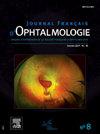Subthreshold nanosecond laser therapy for chronic central serous chorioretinopathy: A prospective study
IF 1.2
4区 医学
Q3 OPHTHALMOLOGY
引用次数: 0
Abstract
Purpose
To investigate the morphologic and functional outcomes of nanosecond subthreshold (ST) laser treatment for patients with chronic central serous chorioretinopathy (CSC).
Methods
In this prospective study, 44 patients were treated with the ST nanosecond laser with a follow-up period of 12 months. All target variables were measured at 1, 3, 6 and 12 months after the first laser treatment.
Results
This study showed a significant improvement in macular sensitivity (MS), a significant reduction in central macular thickness (CMT) as well as a significant reduction in subretinal fluid height (SRF) after 3 months of treatment. The subfoveal choroidal thickness (SFCT) was significantly reduced after 12 months of treatment. However, the best-corrected visual acuity (BCVA) (logMAR) did not change significantly at any time during the study. A high proportion of patients (85%) showed complete resolution of SRF after 12 months, indicating a positive response to treatment in the majority of our patients.
Conclusion
This study showed statistically significant functional improvement in MS as well as significant anatomical reduction in CMT, SFCT and SRF height in CSC patients treated with ST nanosecond laser therapy. Patients with higher SRF at baseline required repeated laser treatments to achieve complete resolution of the SRF.
Objectif
Étudier les résultats morphologiques et fonctionnels du traitement au subthreshold (ST) nanolaser pour les patients atteints de choriorétinopathie centrale séreuse chronique (CCS).
Méthodes
Dans cette étude prospective, 44 patients ont été traités au ST nanolaser avec une période de suivi de 12 mois. Toutes les variables ont été mesurées à 1, 3, 6 et 12 mois après le premier traitement au laser.
Résultats
Cette étude a démontré une amélioration significative de la sensibilité maculaire (SM) et une réduction significative de l’épaisseur maculaire centrale (EMC), ainsi que de la hauteur du liquide sous-rétinien (LSR) après 3 mois de traitement. L’épaisseur choroïdienne sous-fovéale (ECSF) n’a été significativement réduite qu’après 12 mois de traitement. Cependant, la meilleure acuité visuelle corrigée (MAVC) (logMAR) n’a pas changé de manière significative durant l’étude. La majorité des patients (85 %) a montré une résolution complète du LSR après 12 mois, ce qui indique une réponse positive au traitement.
Conclusion
Cette étude a démontré une amélioration statistiquement significative de la SM ainsi qu’une réduction significative de l’EMT, de l’ECSF et de la hauteur du LSR chez les patients atteints de CCS traités au ST nanolaser. Les patients présentant un LSR plus élevé au départ ont dû subir plusieurs traitements pour obtenir une résolution complète du LSR.
阈下纳秒激光治疗慢性中心性浆液性脉络膜视网膜病变:前瞻性研究。
目的:探讨纳秒阈下(ST)激光治疗慢性中枢性浆液性脉络膜视网膜病变(CSC)的形态学和功能预后。方法:在前瞻性研究中,44例患者接受ST纳秒激光治疗,随访12个月。在第一次激光治疗后1、3、6和12个月测量所有目标变量。结果:本研究显示,治疗3个月后,黄斑敏感性(MS)显著改善,黄斑中央厚度(CMT)显著降低,视网膜下液高度(SRF)显著降低。治疗12个月后,中央凹下脉络膜厚度(SFCT)明显降低。然而,在研究过程中,最佳矫正视力(BCVA) (logMAR)在任何时候都没有明显变化。高比例的患者(85%)在12个月后显示SRF完全消退,这表明我们的大多数患者对治疗有积极反应。结论:本研究显示,在接受ST纳秒激光治疗的CSC患者中,MS的功能改善具有统计学意义,CMT、SFCT和SRF高度在解剖学上也有显著降低。基线时SRF较高的患者需要重复激光治疗以达到SRF的完全消退。
本文章由计算机程序翻译,如有差异,请以英文原文为准。
求助全文
约1分钟内获得全文
求助全文
来源期刊
CiteScore
1.10
自引率
8.30%
发文量
317
审稿时长
49 days
期刊介绍:
The Journal français d''ophtalmologie, official publication of the French Society of Ophthalmology, serves the French Speaking Community by publishing excellent research articles, communications of the French Society of Ophthalmology, in-depth reviews, position papers, letters received by the editor and a rich image bank in each issue. The scientific quality is guaranteed through unbiased peer-review, and the journal is member of the Committee of Publication Ethics (COPE). The editors strongly discourage editorial misconduct and in particular if duplicative text from published sources is identified without proper citation, the submission will not be considered for peer review and returned to the authors or immediately rejected.

 求助内容:
求助内容: 应助结果提醒方式:
应助结果提醒方式:


